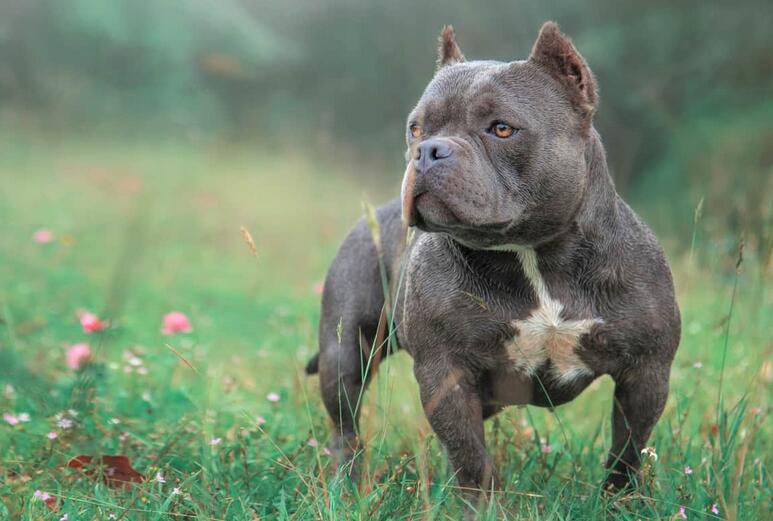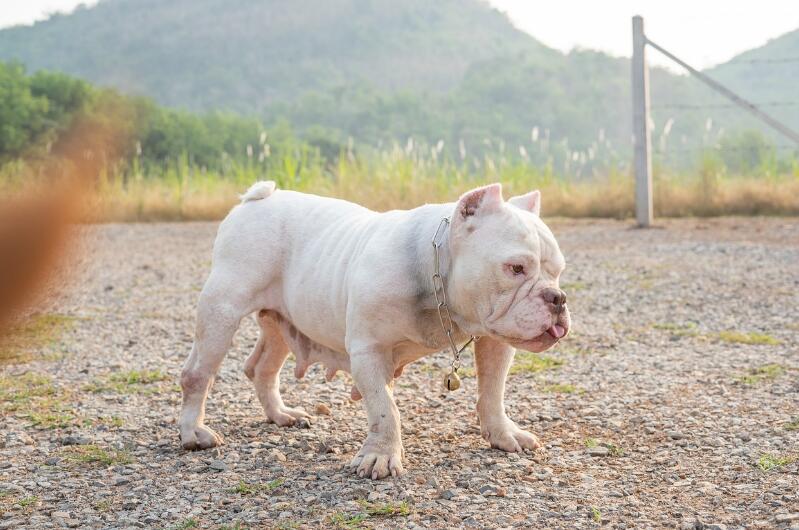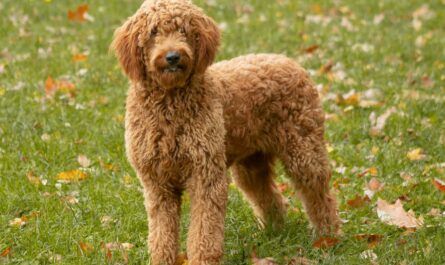The Exotic Bully is a relatively new breed of dog that has been gaining popularity in recent years. It is a small version of the American Bully breed with exaggerated features of smaller Bulldog breeds such as the French Bulldog, Shorty Bull, and English Bulldog.
Exotic Bullies are known for their short, stocky build, broad chests, and oversized heads. They are playful, affectionate, and loyal dogs that make great companions for families and individuals. In the following sections, we will explore the history, traits, and facts about the Exotic Bully breed in more detail.
History of the Exotic Bully
The Exotic Bully is a breed of dog that was first developed in the United States in the late 2000s. It is a relatively new breed and is not recognized by the American Kennel Club (AKC) or United Kennel Club (UKC).
The exact origin of the Exotic Bully is not clear, but it is believed to have been developed by crossing various Bulldog breeds such as the English Bulldog, French Bulldog, and Shorty Bull with the American Bully.
Physical Appearance of Exotic Bullies
1. Size and Weight
Exotic Bully is a medium-sized dog breed that typically weighs between 30 to 60 pounds and stands between 10 to 20 inches tall at the shoulder. They are slightly smaller than the American Bully, which is one of their closest relatives. However, they are still a muscular and robust breed.
2. Coat and Colors
The coat of the Exotic Bully is short, stiff, and glossy. They have a variety of coat colors, including black, blue, brindle, fawn, lilac, and tri-color. Some Exotic Bullies have a solid coat color, while others have a combination of two or more colors. Their coat is easy to maintain and only requires occasional brushing to remove loose hair.
3. Body Structure
The body structure of the Exotic Bully is one of their most distinctive features. They have a large and broad head with a short muzzle, giving their face a flattened appearance. Their eyes are round and set low in the skull, giving them an intense expression. They have a muscular build and a powerful gait. Their hindquarters are broad, strong, and well-muscled, while their chest is deep and wide.

Behavior and Temperament of Exotic Bully
The Exotic Bully is known for its friendly and sociable nature, despite its intimidating appearance. This breed is generally affectionate, loyal, and good-natured, making them excellent companions for families and individuals alike. They are also known to be highly adaptable, making them suitable for both urban and rural environments.
Exotic Bullies are intelligent and eager to please, making them relatively easy to train. They respond well to positive reinforcement techniques such as treats, praise, and playtime. However, they can be stubborn at times, so consistent and patient training is necessary.
This breed is also known for its high energy levels and love of play. They enjoy activities such as fetch, tug-of-war, and going for walks or runs. It is important to note that socialization is crucial for Exotic Bullies. Early socialization with people and other animals can help prevent aggression and fearfulness.
Common Health Issues
Exotic Bullies are susceptible to a number of health issues, including:
- Hip Dysplasia: This is a common condition in which the hip joint does not develop properly, leading to arthritis and pain.
- Skin Allergies: Exotic Bullies are prone to skin allergies, which can cause itching, rashes, and infections.
- Breathing Problems: Due to their short snouts, Exotic Bullies are prone to respiratory issues, such as snoring and difficulty breathing.
- Eye Problems: Exotic Bullies can develop eye problems, such as cherry eye, cataracts, and glaucoma.
It is important for owners to take their Exotic Bullies for regular check-ups with a veterinarian to catch any health issues early. A healthy diet and regular exercise can also help prevent some health issues.
Life Expectancy
The lifespan of an Exotic Bully varies depending on several factors, including diet, exercise, and genetics. On average, Exotic Bullies live between 10 to 12 years. However, some may live longer with proper care.
To ensure a long and healthy life for an Exotic Bully, owners should provide them with a nutritious diet, regular exercise, and regular veterinary check-ups. It is also important to provide them with a safe and comfortable living environment, as stress can negatively impact their health.
Diet Requirements
Exotic Bullies require a balanced diet that is high in protein. Their diet should consist of high-quality dog food that is specifically formulated for their breed. It’s important to avoid feeding them table scraps or human food, as this can cause digestive problems and lead to obesity.
To ensure that your Exotic Bully is getting the right nutrients, you may want to consider feeding them a combination of dry and wet food. Be sure to check the label and choose a brand that contains high-quality protein sources like chicken, beef, or fish.
Exercise Needs
Exotic Bullies are active dogs that require regular exercise to stay healthy and happy. They should be taken for daily walks and given plenty of opportunities to play and run around. However, it’s important to avoid over-exercising them, as they are prone to joint problems.
A good rule of thumb is to provide your Exotic Bully with at least 30 minutes of exercise per day. This can be broken up into shorter sessions throughout the day if necessary. You may also want to consider providing them with toys and puzzles to keep their minds stimulated.
Grooming Tips
Exotic Bullies have short, smooth coats that require minimal grooming. However, it’s important to brush them regularly to remove loose hair and prevent matting. You should also bathe them every few months to keep their coat clean and healthy.
In addition to regular brushing and bathing, you should also trim their nails and clean their ears on a regular basis. This will help prevent infections and keep your Exotic Bully looking and feeling their best.
Price
The price of an Exotic Bully can vary significantly based on various factors such as the dog’s pedigree, bloodline, color, markings, age, breeder reputation, and location.
On average, you may pay anywhere from $1,000 to $4,000 or more for an Exotic Bully puppy from a reputable breeder. Some exceptionally rare or high-quality Exotic Bullies can command even higher prices, exceeding $5,000.
Exotic Bully vs. American Bully: Understanding the Differences
Confusion often arises when distinguishing between the Exotic Bully and the American Bully. While both breeds share a common ancestry, they have distinct characteristics that set them apart.
The American Bully comes in five different sizes or body types: Pocket, Classic, Standard, Extreme, and XL. On the other hand, the Exotic Bully is typically smaller than the American Bully, with a physique reminiscent of a bulldog rather than a Pitbull.
Despite their differences, both breeds possess unique qualities that appeal to dog lovers worldwide.

How to Train an Exotic Bully?
Exotic Bullies are intelligent and eager to please, making them relatively easy to train. However, they can also be stubborn at times, so consistent and patient training is necessary. Here are some tips for training an Exotic Bully:
1. Start with Socialization
Exotic Bullies can be prone to aggression towards other dogs if not socialized properly. Start socializing your Exotic Bully as early as possible to prevent any potential issues. Introduce them to other dogs in a controlled environment and reward them for good behavior.
2. Use Positive Reinforcement
Exotic Bullies respond well to positive reinforcement, such as treats, praise, and playtime. Avoid using physical punishment or negative reinforcement as it can lead to fear and aggression.
3. Be Consistent
Consistency is key when training an Exotic Bully. Use the same commands and training techniques every time to avoid confusion. Establish a routine for training sessions and stick to it.
4. Focus on Basic Commands
Start with basic commands such as sit, stay, come, and heel. Once your Exotic Bully has mastered these commands, you can move on to more advanced training.
Breeding and Puppies
Breeding Exotic Bully dogs requires careful consideration and planning. It is important to choose the right pair of dogs that complement each other’s traits and characteristics. Breeders should ensure that both dogs have good temperaments, are healthy, and are free from any genetic disorders or diseases.
When it comes to breeding Exotic Bully dogs, it is essential to understand the breed’s standards and characteristics. The American Bully Kennel Club (ABKC) and United Kennel Club (UKC) have set standards for the breed, which breeders should follow. The breeding pair should have a similar body structure, head shape, and coat color to produce healthy and high-quality puppies.
Exotic Bully puppies are usually born in litters of 4 to 6 and are ready to be adopted at around 8 to 12 weeks old. It is important to socialize the puppies early on to ensure they grow up to be well-behaved and obedient dogs. Breeders should provide proper nutrition, regular exercise, and veterinary care to ensure the puppies’ health and well-being.
When adopting an Exotic Bully puppy, it is important to choose a reputable breeder who follows ethical breeding practices. A good breeder should provide health certificates for the puppies and their parents, as well as offer support and guidance for the puppy’s care and training.

Exotic Bully in Dog Shows
Exotic Bully is a relatively new breed, and it is not yet recognized by major dog organizations like the AKC or UKC. As such, it cannot participate in official dog shows held by these organizations. However, there are some smaller-scale dog shows and events that allow Exotic Bullies to compete.
One such event is the Bully Breed Coalition (BBC) show, which is exclusively for American Bullies and Exotic Bullies. The BBC show is held annually, and it attracts many breeders and enthusiasts from all over the country. Exotic Bullies can compete in various categories, such as Best Male, Best Female, Best Puppy, Best Micro, and Best Exotic.
Another event that allows Exotic Bullies is the National Bulldogge Association (NBA) show. The NBA show is open to all bulldog breeds, including Exotic Bullies. Exotic Bullies can compete in categories such as Best Male, Best Female, Best Junior, and Best Senior.
Exotic Bullies that participate in these shows are judged based on their adherence to the breed standard, which includes physical characteristics such as head shape, body structure, and coat color. Judges also evaluate the dog’s temperament and behavior during the competition.
Legalities and Controversies Surrounding Exotic Bully
The Exotic Bully breed has been the center of much controversy and legal issues due to the lack of breed standards and the health concerns associated with the breed. While the American Bully breed has an accepted breed standard, the Exotic Bully has yet to establish one, leading to confusion and disagreements within the dog breeding community.
One of the main legal issues surrounding the Exotic Bully breed is the potential for breeding dogs with critical health problems and physical defects. Without specific breed standards, breeders may be tempted to breed dogs purely for their looks rather than their health or temperament, leading to genetic abnormalities that can compromise the health of future generations.
Another legal issue is the potential for misrepresentation of the breed. With no accepted breed standards, individuals within the breed could have questionable genetic backgrounds, leading to confusion and misrepresentation of the Exotic Bully breed.
Despite these legal issues, the Exotic Bully remains a popular breed among dog enthusiasts. However, the breed’s popularity has also led to a rise in unethical breeders who prioritize profits over the health and well-being of the dogs.
Conclusion: Is the Exotic Bully Right for You?
Suppose you are drawn to the exotic appearance and affectionate nature of the Exotic Bully, and you are willing to provide the necessary care and attention. In that case, this breed can make an excellent companion.
However, it’s essential to be aware of the potential health issues and the shorter lifespan associated with this breed. Before bringing an Exotic Bully into your home, thoroughly research reputable breeders and ensure they prioritize the health and well-being of their dogs.





